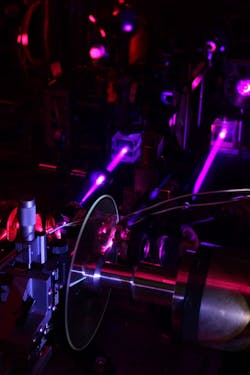OPTICAL DATA STORAGE: 500 Gbyte volume-holographic disc can be written at Blu-ray speed
Researchers at GE Global Research (Niskayuna, NY) have made progress toward their goal of creating a practical 500 Gbyte CD-sized disc based on holographic technology. Aiming to produce an optical disc with enough space to support the increasing requirements of the professional data-archiving industry, they demonstrated a threshold micro-holographic storage material in 2009 that could support 500 Gbytes of storage in a standard DVD-size disc. One drawback: The recording speed was relatively slow. Now, the group has unveiled a version that supports recording at the same speed as standard Blu-ray discs.
Peter Lorraine, manager of the Applied Optics Laboratory at GE Global Research, gave a talk on the new material at the IEEE’s Joint International Symposium on Optical Memory & Optical Data Storage Topical Meeting (July 17–20, 2011; Lihue, Hawaii).
The present design is targeting 20 volume-holographic layers, and the recording is done at the standard Blu-ray wavelength of 405 nm, says Lorraine. “One of the key benefits of our architecture is readout simplicity,” he adds. “A read head for our disc looks (and should cost) almost exactly like an existing Blu-ray head and doesn’t require special thermal or vibration-compensation solutions. This is a key difference from past page-based approaches.”
In page-based volume-holographic discs, a 2D spatial light modulator encodes an array of data all at once, which becomes the basis of a relatively large Fourier volume hologram. In the bit-based approach (GE’s approach), data is recorded a bit at a time, resulting in micro-holograms that can be spatially multiplexed.
Threshold thermoplastic material
“Performance at these levels required several significant material breakthroughs,” says Lorraine. “The material has to be stable, have good optical properties, and enable writing of data without any degradation while reading data. GE has developed a threshold material—one that can be written at higher laser powers but is stable at the lower read powers—in a thermoplastic. The material needs to have a high index change when written, index changes that are local and do not spread, stability under reading power levels, stability over time, and good optical properties, including low scatter.
“With a speed to match Blu-ray’s, discs made from GE’s advanced micro-holographic materials are an attractive solution for both archival and consumer entertainment systems,” says Lorraine. These systems include 3D television, whose data requirement per unit of time is much greater than that for standard high-definition television. The aim will be to create disc hardware and formats similar enough to current optical storage technologies that future micro-holographic players will enable consumers to play back their CDs, DVDs, and Blu-ray discs as well as the holographic discs. The GE team is working toward creating micro-holographic discs that can store more than 1 Tbyte of data per disc. In the months ahead, GE will be sampling media to qualified companies interested in licensing the technology, which includes the holographic materials and discs, optical drive technologies, and optical systems.

John Wallace | Senior Technical Editor (1998-2022)
John Wallace was with Laser Focus World for nearly 25 years, retiring in late June 2022. He obtained a bachelor's degree in mechanical engineering and physics at Rutgers University and a master's in optical engineering at the University of Rochester. Before becoming an editor, John worked as an engineer at RCA, Exxon, Eastman Kodak, and GCA Corporation.
